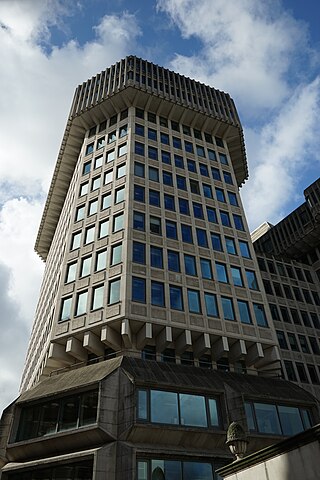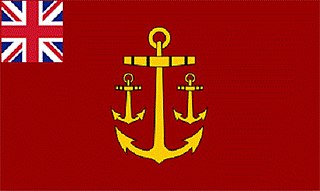
The Admiralty was a department of the Government of the United Kingdom responsible for the command of the Royal Navy until 1964, historically under its titular head, the Lord High Admiral – one of the Great Officers of State. For much of its history, from the early 18th century until its abolition, the role of the Lord High Admiral was almost invariably put "in commission" and exercised by the Lords Commissioner of the Admiralty, who sat on the governing Board of Admiralty, rather than by a single person. The Admiralty was replaced by the Admiralty Board in 1964, as part of the reforms that created the Ministry of Defence and its Navy Department.

Lord Napier, of Merchistoun, is a title in the Peerage of Scotland. It was created in 1627 for Sir Archibald Napier, 1st Baronet. Earlier that year, he already held the Napier Baronetcy, of Merchistoun in the County of Midlothian, created in the Baronetage of Nova Scotia. The titles remained united until 1683, when the Baronetcy became dormant. It was revived in the early 19th century and is now held by another branch of the Napier family. Between 1683 and 1686, the Lords of Napier also held the Nicolson Baronetcy, of Carnock in the County of Stirling, and since 1725 the Scott Baronetcy, of Thirlestane in the County of Selkirk, both baronetcies created in the Baronetage of Nova Scotia. The latter is still held today. Additionally, the tenth Lord was created Baron Ettrick, of Ettrick in the County of Selkirk in the Peerage of the United Kingdom on 16 July 1872.

The Government Legal Department is the largest in-house legal organisation in the United Kingdom's Government Legal Profession.

The Judge Advocate of the Fleet was an appointed civilian judge who was responsible for the supervision and superintendence of the court martial system in the Royal Navy from 1663 to 2008.
Sir John Christopher Sainty, KCB, FSA is a retired British parliamentary official who was Clerk of the Parliaments from 1983 to 1990.

The Permanent Secretary of the Admiralty was the permanent secretary at the Admiralty, the department of state in Great Britain and subsequently the United Kingdom responsible for the administration of the Royal Navy. He was head of the Admiralty Secretariat, later known as the Department of the Permanent Secretary. Although he was not a Lord Commissioner of the Admiralty, he was as a member of the Board, and did attend all meetings. The post existed from 1702 to 1964.
Thomas Phinn, QC was a British barrister and Liberal Party politician. He held various positions in the Admiralty of the United Kingdom in the mid-19th century.

The First Lord of the Admiralty, or formally the Office of the First Lord of the Admiralty, was the political head of the English and later British Royal Navy. He was the government's senior adviser on all naval affairs, responsible for the direction and control of the Admiralty, and also of general administration of the Naval Service of the Kingdom of England, Great Britain in the 18th century, and then the United Kingdom, including the Royal Navy, the Royal Marines, and other services. It was one of the earliest known permanent government posts. Apart from being the political head of the Naval Service the post holder was simultaneously the pre-eminent member of the Board of Admiralty. The office of First Lord of the Admiralty existed from 1628 until it was abolished when the Admiralty, Air Ministry, Ministry of Defence and War Office were all merged to form the new Ministry of Defence in 1964. Its modern-day equivalent is the Secretary of State for Defence.

The Admiralty and Marine Affairs Office (1546–1707), previously known as the Admiralty Office (1414–1546), was a government department of the Kingdom of England, responsible for the Royal Navy. First established in 1414 when the offices of the separate Admiral of the North and West were abolished and their functions unified under a single centralised command, it was headed by the Lord High Admiral of England. The department existed until 1707 when England and Scotland united to form the Kingdom of Great Britain, after which it was known as the British Admiralty.

During the early 17th century, England's relative naval power deteriorated; in the course of the rest of the 17th century, the office of the Admiralty and Marine Affairs steered the Navy's transition from a semi-amateur Navy Royal fighting in conjunction with private vessels into a fully professional institution, a Royal Navy. Its financial provisions were gradually regularised, it came to rely on dedicated warships only, and it developed a professional officer corps with a defined career structure, superseding an earlier mix of sailors and socially prominent former soldiers.

The Glorious Revolution of 1688 rearranged the political map of Europe, and led to a series of wars with France that lasted well over a century. This was the classic age of sail; while the ships themselves evolved in only minor ways, technique and tactics were honed to a high degree, and the battles of the Napoleonic Wars entailed feats that would have been impossible for the fleets of the 17th century. Because of parliamentary opposition, James II fled the country. The landing of William III and the Glorious Revolution itself was a gigantic effort involving 100 warships and 400 transports carrying 11,000 infantry and 4,000 horses. It was not opposed by the English or Scottish fleets.

The Surveyor of Buildings also known as the Department of the Surveyor of Buildings was the civil officer initially a member of the Navy Board then later the Board of Admiralty responsible for superintending, maintaining and improving the British Royal Navy Dockyards, Naval Buildings, and Architectural Works of the Admiralty from 1812 to 1837.

The Naval Works Department was the department of the Inspector-General of Naval Works, Brigadier-General Sir Samuel Bentham, who in 1796 had been given responsibility for modernising and mechanising the Royal Navy dockyards. The Department was established under the direct authority of the Board of Admiralty on 25 March 1796. In 1808 Bentham's job title was changed to Civil Architect and Engineer of the Navy, and he and his department were placed under the oversight of the Navy Board. In 1812 Bentham was dismissed and the department dissolved; most of its responsibilities were taken over by a new Department of the Surveyor of Buildings.

The Navy Office was the government office responsible for the civil administration of the British Royal Navy from 1576 to 1832. It contained all the members of the Navy Board and various other departments and offices. The day-to-day business of the Navy Office was headed by the Clerk of the Acts from 1660 until 1796. When this position was abolished duties were assumed by separate committees for Accounts, Correspondence, Stores, Transports and Victualling presided over by the Comptroller of the Navy. The Navy Office was one of two government offices that were jointly responsible for directing naval affairs. In 1832 following reforms of the naval service the Navy Office was abolished and its functions and staff taken over by the Admiralty.

The Marine Pay Department was formed in 1755, and replaced the earlier Marine Pay Office that was established in 1702. It was responsible for processing marines' pay to the Royal Marine Divisions located at Chatham, Portsmouth, Plymouth and Woolwich. The department was initially administered by the Paymaster of the Marines whose title later changed to the Paymaster and Inspector General of Marines. In 1809 it absorbed the secretariat duties of the Marine Department. The department existed until 1831 as part of the Royal Marine Office when it was abolished and its duties transferred to the Navy Pay Office.

The Solicitor to the Admiralty was established in 1692 as the Solicitor for the Affairs of the Admiralty and Navy. In 1828 his responsibilities to the office were widened when the post was renamed as the Solicitor to the Admiralty. The Solicitor to the Admiralty was the Department of Admiralty's chief legal adviser and legal practitioner who acted on its behalf until 1875 following the abolition of the High Court of the Admiralty.

The Judge of the High Court of Admiralty was established in 1483 he was the chief law officer of the High Court of Admiralty. The office holder was supported by various officials and existed until 1875.

The Directorate Naval Tactical and Weapons Policy originally called the Tactical Section was a directorate of the British Admiralty, and later of the Naval Staff, Ministry of Defence,. Dating from 1920 it operated until 1939 before being abolished. It was revived in 1958 and existed until 1968. The naval staff directorate was administered by the Director, Directorate Naval Tactical and Weapons Policy.

The Navy Department was a former ministerial service department of the British Ministry of Defence responsible for the control and direction of His Majesty's Naval Service. It was established on 1 April 1964 when the Admiralty was absorbed into a unified Ministry of Defence, where it became the Navy Department. Political oversight of the department originally lay with the Minister of Defence for the Royal Navy (1964–1967) it then passed to the Parliamentary Under-Secretary of State for Defence for the Royal Navy (1967–1981), then later to the Parliamentary Under-Secretary of State for the Armed Forces (1981–1990), and finally the Parliamentary Under-Secretary of State for Defence (1991–1997).

The Department of the Storekeeper-General of the Navy was initially the Navy Office department responsible for the storing and supply of naval stores to the Royal Navy established in 1829. In 1832 the Navy Board and subsequently Navy Office was abolished, and their duties were absorbed into the Department of Admiralty.









